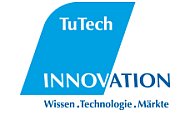Archive for the ‘good practice’ Category
 |
17. September 2012 – 13:49 by John Heaven (TuTech Innovation GmbH)
|
Every year, Bearing Point and Cisco Germany award a project the title of “the most innovative e-government project in the German-speaking world”. This year, the Federal State of Schleswig-Holstein was nominated for their project BOB-SH* in which they implemented DEMOS-Plan, our software for managing spatial planning consultations online. And they won!
So we’ve been feeling a little bit innovative for the past week too. After all, we worked closely with Schleswig-Holstein, giving technical support, training and telephone assistance to the wide range of stakeholders who will be working with DEMOS-Plan.
DEMOS-Plan is an online tool that closely follows the procedure laid down by German law for conducting consultations on a particular type of spatial plan (the “Bebauungsplan”). It allows statutory stakeholders to manage submissions internally by requiring one representative to sign off the submissions from different departments. These submissions can be linked to a particular paragraph of the planning document and/or the participant can draw on a map of the plan.
It’s great for the planning authority, because it saves them the trouble of sending paper copies of plans and collating all the submissions manually: instead, this is done automatically.
We think there are other countries in Europe where DEMOS-Plan could be useful and have been investigating this through the Parterre project. If you were at the PEP-NET Summit, you may have caught Francesco Molinari’s presentation of Parterre. (Hopefully you will also have noticed that the Summit was sponsored by Parterre!)
There will be more news on Parterre soon, so keep your eyes on the blog!
* Bauleitplanung Online-Beteiligung Schleswig Holstein
Posted in good practice, ICT, members, News, Tools, TuTech | No Comments »
 |
25. May 2012 – 13:38 by John Heaven (TuTech Innovation GmbH)
|

Image: Wikimedia Commons, Mrjohncummings
The Welsh town of Monmouth is to become the world’s first “wikipedia town”. In a project that involves kitting out the whole town with free wifi hotspots and sticking QR codes on all significant monuments and places of interest, “Monmouthpedia” enables tourists to call up community-generated articles on their smartphones.
The project doesn’t simply use QR codes that link to a specific article, but to a wikipedia article in the user’s own language where available. This is enabled by the QR-Pedia website, which anyone can use to convert a link from a Wikipedia article into a QR code that ascertains the user’s language an delivers the article in the right language.
I can see this being a success because the QR codes make it much easier to find information about specific objects without having to type in a long, complicated URL, and you have a good idea of what information you are requesting. In many cases, QR codes are used unnecessarily (presumably because they are fashionable) on flyers and posters and link to a company’s website, which would be easier to call up by typing in the URL or searching for it. I also find that you often do not know what the QR code links to, which isn’t a great motivating factor either.
Another innovative example of QR code use is the Korean supermarket in an underground station that consists of pictures of products, each with an associated QR code. Again, the QR code links to a very specific object and it’s obvious what you can expect when you scan the code.
Posted in good practice | 2 Comments »
 |
23. May 2012 – 09:53 by irmatolonen
|
The inclusion of immigrants is vital for social cohesion and economic development. To enable immigrants to feel part of a larger society it is necessary to ensure that they have proper possibilities to participate fully in the society. The Immigrant Inclusion by eParticipation – IIeP project: www.iiep-project.eu/(1.10.09 – 30.4.2012) focused on obstacles on the way of participation and public engagement for people from various language and cultural backgrounds that reside in Estonia, Finland and Sweden, and solutions to overcome these using web-based social and communication tools.
The two manuals: “E-inclusion guidelines: supporting diversity” and “E-Participation guidelines: supporting diversity”, published in English, Estonian, Finnish and Swedish are the main outcomes from the IIeP – EU/Central Baltic INTERREG IVA project. These outputs found online and in pdf-versions on the new website: www.supportingdiversity.eu are aimed to meet the needs for those involved in participatory processes and immigrant involved issues. They also provide ideas and best practices for authorities to facilitate inclusion. The manuals can be used widely to support residents´ active participation in local multinational communities.
Posted in good practice, Projects | No Comments »
 |
22. May 2012 – 10:09 by Asociacion Ciudades Kyosei / Pedro Prieto-Martin
|
 This week Avaaz, the “campaigning community bringing people-powered politics to decision-makers worldwide’, started the beta-testing of its community petitions platform, which allows anybody to launch a petition in a question of minutes. This new systems empowers anybody to make use of the streamlined processes and tools that have allowed Avaaz to grow its user base to more than 14.400.000.
This week Avaaz, the “campaigning community bringing people-powered politics to decision-makers worldwide’, started the beta-testing of its community petitions platform, which allows anybody to launch a petition in a question of minutes. This new systems empowers anybody to make use of the streamlined processes and tools that have allowed Avaaz to grow its user base to more than 14.400.000.
 Avaaz thus follows the recente move from change.org, the “social action platform that empowers anyone”, which just two weeks ago ‘absorved’ the Spanish platform “Actuable” and is now planning to translate its ‘petition making system’ to many other languages to really extend its reach worldwide.
Avaaz thus follows the recente move from change.org, the “social action platform that empowers anyone”, which just two weeks ago ‘absorved’ the Spanish platform “Actuable” and is now planning to translate its ‘petition making system’ to many other languages to really extend its reach worldwide.

Each of these platforms claims to have promoted petitions that forced very important political ‘actors’ to react: from Hillary Clinton to Presidente Morales, from Bank of America and Apple to Hilton Hotels.
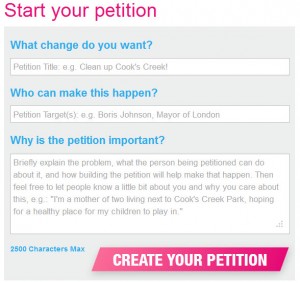 This is an interesting ‘tectonic’ move in the realm of (e)Participation, which we should follow closely. It is, additionally, much related to the discussion about “Sticks and Carrots” we hold in Pep-Net’s blog a year ago.
This is an interesting ‘tectonic’ move in the realm of (e)Participation, which we should follow closely. It is, additionally, much related to the discussion about “Sticks and Carrots” we hold in Pep-Net’s blog a year ago.
We were then reflecting about questions like: is it better to praise “good deeds” of Corporation and Politicians, or is it better to warn and punish them when they “misbehave”? Why not both things at the same time?
Anita Roddick, the founder of the Body Shop, reported that once an executive of Shell told her: “We don’t fear regulation, we only fear consumer revolt”
Well: it is clear now that consumer and citizens are getting better at revolting and exerting pressure. Change is happening out of anybody’s reach, and (e)Participation is slowly “getting teeth”, which soon will be able to hurt enough as to influence behaviour: if you do not want your brand reputation to get ruined… you better behave!!! And this applies to corporation as much as political actors.
The promise of a ‘Future Goverment’ that becomes FAST (flatter, agile, streamlined and tech-enabled) -which was delivered in the last World Economic Forum- starts to be truth. But, for sure, it is not government who is promoting it. It is NGOs and CSOs. It is citizens.
It is important to note that the technology behind these petition plattforms is very, very simple. The concepts and processes of use are also not sci-fiction. But for sure, this kind of powerful, sustainable and social minded (e)Participation was rarely promoted by our Governments’ Innovation Support Actions. Instead of an impact oriented eParticipation research, put at the service of Civil Society, a Government- and Academia-centred approach was preferred. And thus eParticipation has just advance by little steps.
It is a pitty, because these platforms are now out there, growing. They were created with less (or ‘no’) involvement of eParticipation researchers. And that means that we do not have easy access to the very valuable information about eParticipation that these systems are generating (about pattern and reasons of use, users’ demographics, typologies of action, success rates, etc).
We should reflect about this. We have not so many more opportunities to miss. The field is developing faster and faster. Do we want to be part of it?
Posted in good practice, ICT, inclusion, Tools, Trends, Visions | No Comments »
 |
17. April 2012 – 09:08 by Fraser Henderson - ICELE
|

A new digital engagement database is launched today by ParticiTech and Kind of Digital in association with Consumer Focus (UK).
Digitalengagement.org is different from other digital engagement databases in that it is a methods repository, not case study database. The website also doubles as a search engine, allowing methods to be matched based on a set of simple input criteria relating to the participation characteristics.
Give it a whirl and let me know what you think!
Read the full press release here
Posted in good practice, Projects, Tools | No Comments »
 |
6. October 2011 – 18:31 by John Heaven (TuTech Innovation GmbH)
|
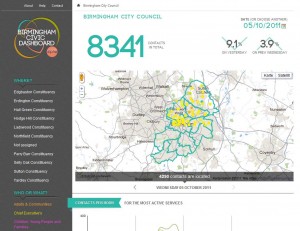
Birmingham Civic Dashboard screenshot
In its recent consultation document ‘Making Open Data Real’, the UK Government expresses high hopes for open data, heralding it as possibly “the most powerful lever of 21st century public policy”. Following several years of open data advocacy, activism and hack days, in the UK open data is moving towards the mainstream thanks to unanimous backing from the coalition government and the opposition.
The latest move in open data comes from Birmingham City Council, which today launched its ‘Civic Dashboard’. This is a web site publishing raw customer services data along with a slick visualisation, which was made possible by a grant that Digital Birmingham received as a result of winning a competition run by the National Endowment for Science, Technology and the Arts (NESTA).
The Civic Dashboard draws its data from the customer service centre set up as part of the Council’s Business Transformation programme. An extract of data about all customer enquiries, whether by telephone, internet or email, is recorded by the customer relationship management system and fed into the Civic Dashboard in an aggregated (anonymised) form once per day. Where the data is geocoded, it can be presented on a map to show how many contacts originate from a particular ward or constituency. You can even see which channels the enquiries come through, which shows that the Council receives far more enquiries by telephone than through other channels.
This is an important step towards bridging the gap between eGovernment and ‘weGovernment’. Coming from the Council that was heavily criticised for spending £2.8m on its website as part of its eGovernment transformation, especially by Birmingham’s vocal social media users, opening up the data that is produced in the background shows what the new infrastructure can do beyond serving up static content. Doubtless there are many more datasets that exist as a result of the transformation programme, and if these are released in the future, perhaps Brummies will feel they got a better deal out of transformation than they first thought.
This itself is quite a paradox: such a handover of control to the citizen wouldn’t have happened if it weren’t for the huge transformation programme because IT is absolutely necessary for the collection of data in a reusable form.
Read the rest of this entry »
Posted in good practice, News, open data, Trends | 1 Comment »
 |
7. September 2011 – 10:33 by Fraser Henderson - ICELE
|
 The Consultation Institute (TCI) have launched what they believe to be the first quality scheme for public engagement software. Software vendors can apply for their tool to be tested against the principals of the TCI consultation charter which is a set of good practices. Assurances are also sought from existing customers and the package of training, support and help are scrutinised.
The Consultation Institute (TCI) have launched what they believe to be the first quality scheme for public engagement software. Software vendors can apply for their tool to be tested against the principals of the TCI consultation charter which is a set of good practices. Assurances are also sought from existing customers and the package of training, support and help are scrutinised.
This results in a test report, including actions and recommendations for product development enhancement generated by experts in eParticipation. Software and services which meet a certain grade will be granted the use of a logo which can be used on all marketing materials as a sign of product confidence.
An announcement will be made on 29th September regarding the first vendor to achieve successful accreditation during the annual TCI ‘Technologies for public engagement and consultation event’ (London).
For enquiries, please email Fraser.henderson@btinternet.com
Posted in good practice, Tools | 2 Comments »
 |
6. September 2011 – 15:15 by John Heaven (TuTech Innovation GmbH)
|
 Nikolaus Münster is Head of Press and Public Relations at the City Council in Frankfurt/Main, Germany. I spoke to him about the city’s “Social Media Newsroom“, which gathers content from all of its social media channels and presents it on one website.
Nikolaus Münster is Head of Press and Public Relations at the City Council in Frankfurt/Main, Germany. I spoke to him about the city’s “Social Media Newsroom“, which gathers content from all of its social media channels and presents it on one website.
Nikolaus gained inspiration for the idea when he took part in a European exchange programme in 2009, completing a secondment at Birmingham City Council. That is where I met him and where he learned about Birmingham News Room. Apart from anything, I think this is a nice bit of European best practice exchange, which can often be hard to quantify. It’s also nice to see Frankfurt getting something in return for the Christmas Market that they send to Birmingham ever winter!
John Heaven (JH): What is a Social Media Newsroom?
Nikolaus Münster (NM): Our Social Media Newsroom brings together all of our social media channels on one website. The user can view this site to see news about the city on Twitter, Facebook, blogs, YouTube and other media at a glance.
We have been using these means of communication for a while now. Since 2009 we have been on Facebook, Twitter and Youtube. When we started we wanted to gain experience before actively publicising our social media presences. Now, social media are central to our communication strategy.
JH: What is the main aim of the Newsroom?
Read the rest of this entry »
Posted in good practice, Interview, News, Projects | No Comments »
 |
3. August 2011 – 14:58 by Rolf Luehrs
|
We have extended the deadlines for the call for chapter proposals for our book Sustainable eParticipation:
Researchers and practitioners are invited to submit on or before August 31, 2011, a 2-3 page chapter proposal clearly explaining the scope and contents of their proposed chapter. Authors of accepted proposals will be notified by September 15, 2011 about the status of their proposals and sent chapter guidelines. Full chapters are expected to be submitted by October 30, 2011. All submitted chapters will be reviewed on a double-blind review basis. Contributors may also be requested to serve as reviewers for this project.
For more information see our previous post: https://pep-net.eu/blog/2011/06/26/call-for-chapter-proposals-sustainable-eparticipation/
Posted in good practice, Projects | No Comments »
 |
21. July 2011 – 17:45 by John Heaven (TuTech Innovation GmbH)
|
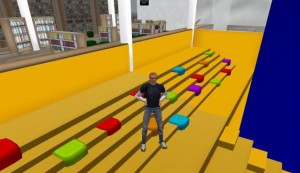
Me, posing in Second Life
This morning I went for a walk in a place on the other side of the channel which doesn’t exist yet. All without leaving my desk. Thanks to Birmingham’s Second Life model of the Library of Birmingham, the real life version of which is due to be opened in 2013, I was able to have a look at what they’re planning.
A couple of months back I blogged about Birmingham’s virtual model of the Library of Birmingham, then in the later stages of development. Earlier this month the Virtual Library went live, meaning that people from Birmingham (and beyond) can see a virtual model of the library that is scheduled to open in 2013 and let the developers know what they think.
As a Brummie, I recognised Centenary Square, and it was clear where the new library will be located and easy enough to get in (although Second Life can take a bit of getting used to before you start walking like you’re sober). Almost all areas of the library are accessible, and you can even choose whether to take the escalators or teleport to the different floors. It gives a good feel of how the library will eventually look and I noticed that some people had already commented on the building: one visitor was “concerned about the floor — it might do your head in!” and someone advised “Make sure the tables are able to be used by disabled people and children.”
As I mentioned in my previous article, the Virtual Library launch is being accompanied by a range of activities to ensure that it doesn’t go unnoticed in Second Life. Regular workshops are being held at the current library for the public, who are then able to use the computers at the library to access Second Life or go home and try it themselves. Those who don’t fancy signing up for Second Life can either view fly-through videos of the library or submit their comments using questionnaires.
For more information about the launch of the Virtual Library, you see the press releases from Birmingham City Council and from Daden, the company that created the model. I’m going to get an update from library staff after their current phase of outreach work, so watch this space!
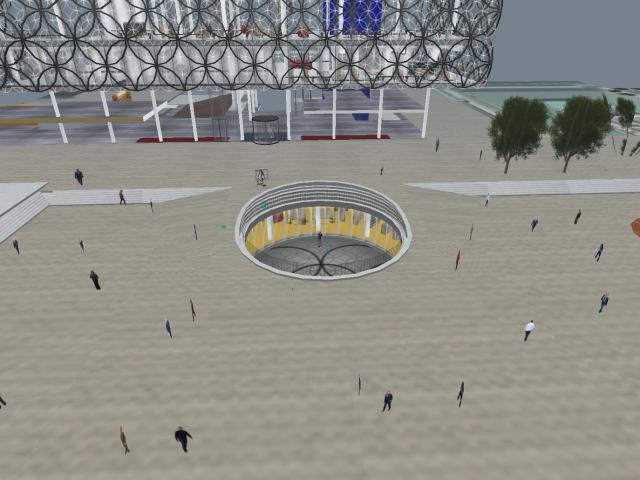
Can you spot me?
Posted in good practice, News, Projects, Trends | 2 Comments »









 Nikolaus Münster is Head of Press and Public Relations at the City Council in Frankfurt/Main, Germany. I spoke to him about the city’s “Social Media Newsroom“, which gathers content from all of its social media channels and presents it on one website.
Nikolaus Münster is Head of Press and Public Relations at the City Council in Frankfurt/Main, Germany. I spoke to him about the city’s “Social Media Newsroom“, which gathers content from all of its social media channels and presents it on one website.






